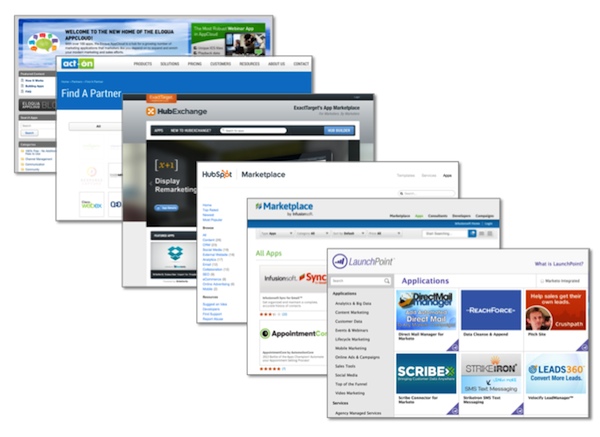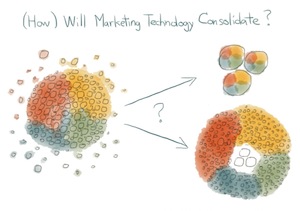
Will marketing technology consolidate into a handful of behemoth super-platforms? Or will it continue to diversify with more innovative new software?
My theory on marketing technology consolidation vs. diversification has been both.

I believe that a set of “backbone” platforms will serve as the foundation of marketing’s technology infrastructure, but they will promote open APIs and robust third-party developer communities. Marketers will have the best of both worlds: a coordinating platform for standardized data and back-end processes, strategically enhanced with select point solutions for differentiated marketing capabilities.
But that’s been just a theory up to now.
However, with a news release today — that marketing automation provider Act-On Software has expanded their partner ecosystem by opening their APIs to third-party developers — it struck me that the theory may now have empirical evidence to support it.
Act-On now joins the ranks of many other marketing automation platforms that have developed open APIs and featured “marketplaces” to promote third-party applications that plug into their backbone:
Although I could not find an app marketplace for Pardot, they do promote an open API, their mothership ExactTarget has a robust HubExchange with over 75 apps, and their mother-mothership Salesforce.com set the bar for third-party developer SaaS ecosystems with their AppExchange with over 1,000 apps.
Admittedly, there are other marketing automation providers — Adobe and Neolane (which Adobe acquired), Responsys, and Teradata Applications (formerly Aprimo) — who don’t emphasize third-parties as much. They endorse a smaller number of partners on their websites, who are presented more as explicit partnerships rather than an open third-party developer community:
Even further down the spectrum, for IBM’s Enterprise Marketing Management platform (the core of which was previously Unica) and SAS’s Customer Intelligence platform (which includes a marketing automation module), I could find almost no third-party applications mentioned on their websites. I am certain that they do integrate with some third-party products, but they don’t make that a prominent part of their web marketing.
At the risk of someone crying, “Objection, Your Honor, speculation!”, I can’t help but wonder if the difference across these companies is the degree to which they see an emphasis on third-party developers and open APIs as a strength or a weakness.
Can your solution be considered “complete” if you make a big deal about all the things you can plug into it? I would argue, yes. They don’t have to be mutually exclusive statements, as companies from Apple to Salesforce.com have demonstrated. It’s the difference between a suite strategy vs. a platform strategy. Do you believe marketing benefits from more of an open platform? If so, then a thriving third-party developer community is a great strength.
Framed another way, do you believe the API economy is indeed emerging and will grow to be a significant part of marketing in a digital world? (“Objection, leading the witness!”)
It will be interesting to see if Adobe, IBM, Responsys, SAS, and Teradata will evolve to a more engaged third-party developer strategy in the years ahead.
So what types of third-party applications are being offered? Here’s a small sample:
- Content marketing workflow management and optimization from Kapost
- Call tracking for leads originating on the web from Ifbyphone
- Webinar registration and delivery from Citrix GoToWebinar
- B2B data profiles and personalization from Demandbase
- Predictive sales and marketing analytics from Lattice Engines
- Rich media advertising and content modules from Kwanzoo
- Interactive content, such as contests and polls, from SnapApp
- Content curation discovery, organization, and deployment from Curata
- Advanced landing pages, microsites, and mobile web apps from ion interactive (disclaimer: my company)
And many more. Third-party applications range from customer-facing applications that deliver better or more specialized experiences to more advanced back-end data analysis and management capabilities, and everything in between.
In browsing through the more mature marketplaces — such as Eloqua’s and Marketo’s — the breadth and depth of the different applications available makes a strong case that it would be impractical for a single vendor to have all of these capabilities built into their core product. Within a particular category, such as B2B data profiles, having more than one alternative to choose from keeps those providers competitive and continually innovating new, differentiated features.
And it’s great to see many of these third-party developers represented across multiple platform marketplaces. This demonstrates that third-parties can achieve a wide reach across many different backbone providers — enough to achieve significant scale in their own speciality.
In a way, it’s standardization in the other direction. Everything that plugs into your marketing automation platform adheres to the data exchange rules of that API. But at the same time, a product like Kapost offers you consistent content marketing workflow whether you use it with Eloqua, HubSpot, or Marketo.
I also found it highly encouraging that Eloqua, which started their third-party marketplace back in 2010, claims that over 90% of their customers have tried out apps from the Eloqua AppCloud. It’s evidence that, given the opportunity to plug-and-play more specialized marketing apps into their marketing automation backbone, marketers will happily do so.
Finally, I would also argue that by embracing third-party developers, marketing automation providers are in a position to significantly broaden the applicability of their platforms. In a quick Q&A I had with Atri Chatterjee, the CMO of Act-On, about today’s announcement, he agreed that this “broadens the approach” of marketing automation.
“Marketing automation technology provides a lot of rich profile data that can be used to augment our customers’ other applications, as well as improve Act-On campaign through real-time external data sharing. Marketing is increasingly interfacing with other functions, and those function in turn need information from the marketing platform.” (Emphasis added is mine.)
It sure seems like the third-party era of marketing automation is emerging.




Consolidation will certainly be the sort term trend, but ultimately third-party diversification will be more influential in the end because the younger generation will always develop habits different from the established markets, and I think it’s the smaller more flexible vendor that’s usually better at identifying and servicing these markets.